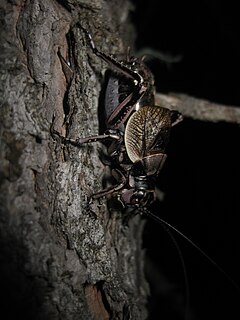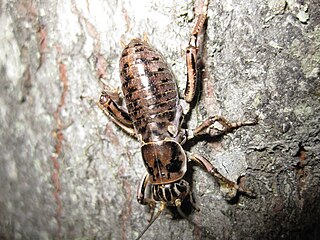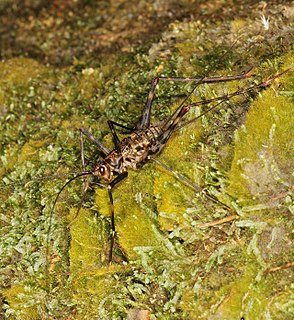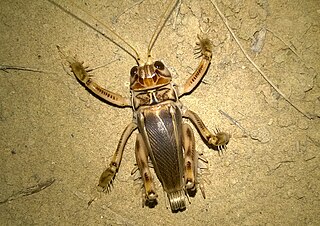 W
WEnsifera is a suborder of insects that includes the various types of crickets and their allies including: true crickets, camel crickets, bush crickets or katydids, grigs, weta and Cooloola monsters. This and the suborder Caelifera make up the order Orthoptera. Ensifera is believed to be a more ancient group than Caelifera, with its origins in the Carboniferous period, the split having occurred at the end of the Permian period. Unlike the Caelifera, the Ensifera contain numerous members that are partially carnivorous, feeding on other insects, as well as plants.
 W
WThe Orthopteran subfamily Aemodogryllinae contains about sixteen genera of camel crickets. It was named after Aemodogryllus Adelung, 1902 - which is now considered a subgenus of Diestrammena.
 W
WAllonemobius allardi, the Allard's ground cricket, is a species of ground crickets in the family Gryllidae. It is found in North America.
 W
WThe Myrmecophilidae or ant-loving crickets are rarely encountered relatives of mole crickets, and are obligate inquilines within ant nests. They are very small, wingless, and flattened, so resemble small cockroach nymphs. The few genera contain fewer than 100 species. Ant crickets are yellow, brown, or nearly black in color. They do not produce sound, and lack both wings and tympanal organs ("ears") on the front tibia.
 W
WThe Cachoplistinae is a subfamily of crickets of the family Phalangopsidae; they are sometimes called beetle crickets. Species are terrestrial, carnivorous or omnivorous and can be found in: Africa, tropical Asia, Korea and Japan.
 W
WCyphoderris buckelli, or Buckell's grig, is a species of hump-winged cricket in the family Prophalangopsidae. It is found in North America.
 W
WCyphoderris monstrosa, also known as the great grig, is a species of hump-winged grig in the family Prophalangopsidae. It is found in North America.
 W
WElcanidae are an extinct family of Mesozoic and early Cenozoic ensiferans. Members of the family are distinguished by the presence of spurs on the distal part of the metatibia, unique among orthopterans, these have been suggested to have been used for controlling gliding, swimming aids, or for jumping on water. They are known from the Late Triassic to Paleocene of Eurasia, North and South America.
 W
WThe family Gryllidae contains the subfamilies and genera which entomologists now term true crickets. They belong to the Orthopteran subfamily Ensifera, having long, whip-like antennae and has been reduced in terms of the older literature, with taxa such as the spider-crickets and allies, sword-tail crickets, wood or ground crickets and scaly crickets elevated to family level. The type genus is Gryllus and the first use of the family name "Gryllidae" was by Walker.
 W
WGryllidea is an infraorder that includes crickets and similar insects in the order Orthoptera. There are two superfamilies, and more than 6,000 described species in Gryllidea.
 W
WGrylloidea is the superfamily of insects, in the order Orthoptera, known as crickets. It includes the "true crickets", scaly crickets, wood crickets and other families, some only known from fossils.
 W
WMole crickets are members of the insect family Gryllotalpidae, in the order Orthoptera. Mole crickets are cylindrical-bodied insects about 3–5 cm (1.2–2.0 in) long as adults, with small eyes and shovel-like fore limbs highly developed for burrowing. They are present in many parts of the world and where they have arrived in new regions, may become agricultural pests.
 W
WThe Gryllotalpoidea are a superfamily of insects that includes the mole crickets and the ant crickets. The type genus is Gryllotalpa.
 W
WThe superfamily Hagloidea are insects belonging to the order Orthoptera: Ensifera; they are now represented by the extant Prophalangopsidae, with many extinct genera and families.
 W
WHemideina crassidens, commonly known as the Wellington tree wētā, is a large, flightless, nocturnal insect in the family Anostostomatidae. This wētā species is endemic to New Zealand and populates regions in the southern half of North Island/Te Ika a Maui and the north-west of the South Island/Te Wai Pounamu. They forage arboreally during the night and are most likely polyphagous. There is obvious sexual dimorphism in adults. Individuals are reliant on tree cavities for refuge, social interactions and mating.
 W
WHomoeogryllus orientalis, the South African bell cricket, is a species in the tribe Homoeogryllini of the subfamily Cachoplistinae. The species is reported from southern tropical Africa including parts of Mozambique and South Africa. Within South Africa it has been reported south of the tropics in the Bushveld and in the Free State.
 W
WHump-winged grigs are insects belonging to the North American genus Cyphoderris, in the family Prophalangopsidae, related to katydids.
 W
WLeptophyes laticauda is a species of bush-crickets belonging to the family Tettigoniidae.
 W
WMogoplistidae is a family of scaly crickets within the superfamily Grylloidea. Considered to be monophyletic, a sister taxon to the Gryllidae crickets. This family consists of 30 genera and 364 species worldwide; 20 species in 4 genera occur in North America and this family includes the scaly crickets of Europe.
 W
WThe Myrmecophilidae or ant-loving crickets are rarely encountered relatives of mole crickets, and are obligate inquilines within ant nests. They are very small, wingless, and flattened, so resemble small cockroach nymphs. The few genera contain fewer than 100 species. Ant crickets are yellow, brown, or nearly black in color. They do not produce sound, and lack both wings and tympanal organs ("ears") on the front tibia.
 W
WMyrmecophilus acervorum is an orthopteran insect belonging to the family Myrmecophilidae. This continental European species is probably the most widespread and most frequently encountered member of this rather obscure family found in Europe. It is also by far the smallest orthopteran found in Western Europe, with its total adult length never exceeding 3.5 mm (0.14 in).
 W
WThe Phalangopsidae are a recently reconstituted family of crickets, based on the type genus Phalangopsis Serville, 1831 from South America. Priority for family-group names based on this genus dates from Blanchard's "Phalangopsites".
 W
WThe Phylloscyrtini tribe is a group of 21 species of small crickets in the New World, from the eastern United States to Argentina. Little is known about their biology.
 W
WThe family Prophalangopsidae are insects belonging to the order Orthoptera. There is only one extant genus in North America, where they are known as grigs, four genera in Asia, and many extinct genera.
 W
WThe orthopteran family Rhaphidophoridae of the suborder Ensifera has a worldwide distribution. Common names for these insects include the cave wētā, cave crickets, camelback crickets, camel crickets, spider crickets and sand treaders. Those occurring in New Zealand, Australia, and Tasmania are typically referred to as jumping or cave wētā. Most are found in forest environments or within caves, animal burrows, cellars, under stones, or in wood or similar environments. All species are flightless and nocturnal, usually with long antennae and legs. More than 1100 species of Rhaphidophoridae are described.
 W
WSchizodactylidae is a family of orthopteran insects found in Asia and Africa, known as dune crickets or splay-footed crickets. They are usually found in desert and sandy areas. Species are predatory, including Schizodactylus inexspectatus. T. B. Fletcher notes that one captive individual did not feed on any vegetable matter.
 W
WSchizodactylus monstrosus or the maize cricket, is a species of large, robust cricket found in Asia, belonging to the family Schizodactylidae. It is found mainly in sandy habitats along rivers, and has large flattened tarsal extensions and wings that are curled at the tip, right above the cerci. They are nocturnal and show a high degree of variation in activity during the day and night. They hide in burrows that they dig on their own during the day.
 W
WTettigoniidea is an infraorder of the order Orthoptera, with six extant families.
 W
WThe Trigonidiidae are a family of crickets: Grylloidea consisting of two subfamilies:Subfamily Nemobiinae Saussure, 1877 – wood crickets or ground crickets Subfamily Trigonidiinae Saussure, 1874 – sword-tail crickets